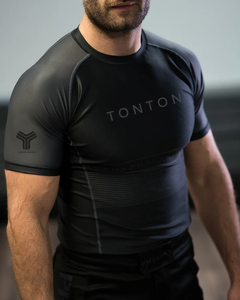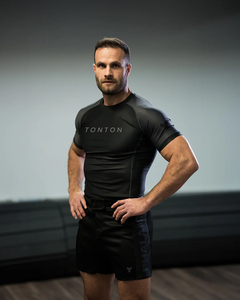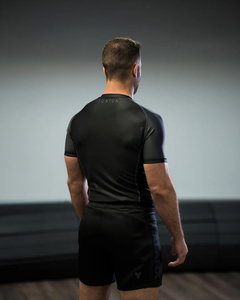
All categories
Featured selections
Trade Assurance
Buyer Central
Help Center
Get the app
Become a supplier

(34278 products available)




















































A Jiu Jitsu gi is a traditional uniform used in Brazilian Jiu-Jitsu (BJJ) and Japanese Jiu-Jitsu. It consists of a jacket, pants, and a belt, designed for comfort and mobility during grappling and submission training. Here's a breakdown of its types:
Competition Jiu Jitsu Gi
The competition Jiu Jitsu Gi is crafted explicitly for use in tournament settings. This Jiu Jitsu Gi style is developed to meet the requirements outlined by governing bodies in the sport. Typically, they possess a snug fit, which minimizes the potential for an opponent to grip onto the fabric easily. They are often made from a lighter material such as cotton or a cotton-polyester blend. This ensures comfort and allows for ease of movement. The jacket and pants are uniformly reinforced at strategic points to enhance durability. This is because competitions commonly involve intense grappling.
Training Jiu Jitsu Gi
Training Jiu Jitsu Gi refers to the Gi that is utilized during practice sessions and training. This Gi is slightly distinct. Their primary focus is on comfort and durability. They may not adhere strictly to competition specifications. They are commonly crafted from heavier and more resilient materials. This ensures they can withstand the wear and tear of frequent use. They are usually made from cotton or cotton blends. They can come in different colors and styles. They include both traditional and more modern variations designed to enhance mobility and provide a comfortable experience.
Lightweight Gi
Lightweight Gi is the style of Jiu Jitsu Gi that is designed to be lightweight. This Gi is the best choice for practitioners who prefer a less restrictive and more agile feel. These Gi are typically constructed from thinner materials. For instance, cotton or cotton-polyester blends. This reduces the overall weight of the uniform while still maintaining adequate durability and quality. The lightweight design of these Gi is particularly beneficial in warmer climates or for those who want to enhance their speed and mobility during training and competition.
Heavyweight Gi
Heavyweight Gi is characterized by their robust and substantial construction. These Gi are usually crafted from thicker, denser materials. For instance, cotton or cotton blends. This provides a durable and long-lasting uniform that can withstand rigorous training sessions and multiple washes without significant wear and tear. The heavyweight design offers added protection and support, making it ideal for practitioners who prefer a more traditional and secure feel in their Jiu Jitsu uniform. Additionally, the heavier fabric can offer strategic advantages during grappling by providing a more substantial grip and resistance.
Preshrunk Gi
Preshrunk Gi is a term used to refer to Jiu Jitsu Gi that has undergone a pre-shrinking process during manufacturing. This Gi eliminates concerns about further shrinkage after the first few washes. These Gi are typically crafted from cotton or cotton blend fabrics. This ensures a consistent fit right out of the package and maintains it over time, even after multiple washes. By opting for a preshrunk Gi, practitioners can avoid the hassle of adjusting to a smaller, altered fit that often occurs with unshrinked cotton Gi. This offers a more convenient and reliable choice for Jiu Jitsu enthusiasts of all levels.
Women’s Gi
This Gi is specifically crafted for women practitioners of Jiu Jitsu. Normally, they are designed to offer a comfortable and functional fit that caters to the unique requirements of women in the sport. Typically, these Gi come in various colors. For instance, white, blue, and black. They are accompanied by different belt colors that signify rank and skill level. The Gi usually consists of a jacket and pants made from durable and breathable fabrics such as cotton or a cotton-polyester blend. This ensures ease of movement and withstands the rigors of training and competition. The women’s Gi is usually tailored to provide a more contoured fit, enhancing comfort and performance during matches or training sessions.
Jiu Jitsu Gi has various designs; here are some of them:
Material and Weave
The fabric and weave of a Jiu Jitsu gi are essential for performance and longevity. A thick fabric with a tight weave provides durability and protection against tearing. For example, the Pearl Weave is a popular choice for its balance of strength and flexibility. It offers a robust construction that withstands intense training while allowing ease of movement. Another common material is the cotton-polyester blend, which combines the breathability of cotton with the durability of polyester.
Collar Design
The collar of a Jiu Jitsu gi plays a crucial role in both competitive and training settings. A stiff, thick collar is preferred for competition. It provides a solid grip for opponents attempting to control the head and neck. The collar's rigidity makes it challenging for opponents to achieve a secure grip. This helps neutralize their control attempts. In training, versatile collar options are available. They offer varying degrees of stiffness. This allows practitioners to choose a gi that suits their training goals and preferences.
Reinforcement and Stitching
Reinforcement and stitching are key factors in ensuring the longevity and durability of a Jiu Jitsu gi. Critical stress points, such as the shoulders, sleeves, and pant openings, are reinforced with double or triple stitching. This prevents premature wear and tear from the rigorous movements and pulls involved in Jiu Jitsu. High-quality cotton threads are used for stitching. They provide strength and resilience, ensuring that the seams hold up over time. The reinforcement of seams and high-stress areas contributes to the overall durability of the gi, allowing practitioners to train with confidence without worrying about the gi's integrity. This attention to reinforcement and stitching ensures that the gi can withstand the demands of training and competition, providing reliable performance.
Fit and Cut
Different styles of Jiu-Jitsu have different fits. The traditional cut offers a loose, relaxed fit, allowing for unrestricted movement. This is preferred by those who prioritize comfort and ease of movement. The slim fit, on the other hand, provides a more streamlined and modern appearance. This is suitable for those who prefer a snugger fit without compromising mobility. The tailored cut offers a customized fit. It is designed to contour the body's shape. This provides a balance between comfort and a fitted look.
Lapels and Sleeves
Lapels and sleeves come in different thicknesses. They impact grip and control in Jiu-Jitsu. Thick lapels provide a solid grip. They are preferred in competition for their resistance against opponent control. Thin lapels offer a lighter feel, which is suitable for training and faster-paced rolling sessions. The sleeves also vary in thickness and stiffness. Stiffer sleeves are harder to grip and control. This is advantageous for defensive strategies. Softer sleeves allow for easier grip establishment, facilitating offensive strategies.
White, blue, and black are the three colors of the BJJ gi. Each has its unique meaning and use in the sport.
The following are suggestions on how to wear and match the different colored belts and Gis:
White Gi
A white gi is the most commonly used BJJ uniform. It is the standard for beginners and advanced practitioners. The white gi symbolizes purity and openness. It is a blank slate for the student. The white gi pairs well with all belt colors. It is easy to clean and maintain. The white color shows dirt easily. This can be a drawback for some. The white gi is suitable for all classes and competitions. It is a sign of respect for the art and its traditions. The white color is neutral and allows the practitioner to focus on their skills. The white gi is a classic choice for BJJ.
Blue Gi
Blue gis are popular in BJJ. They are the second most popular after the white ones. The blue color is associated with calm and trust. It is a good choice for training and competition. The blue gi pairs well with all belt colors. It is a practical choice for training. The blue color hides stains better than white. This can be a benefit for some. The blue gi is suitable for all classes and competitions. It is a sign of respect for the art and its traditions. The blue color is neutral and allows the practitioner to focus on their skills. The blue gi is a reliable choice for BJJ.
Black Gi
Black gis are a sign of sophistication and authority. They are a good choice for advanced practitioners. The black gi pairs well with all belt colors. It is a formal choice for training and competition. The black color does show stains more than white. This can be a drawback for some. The black gi is suitable for all classes and competitions. It is a sign of respect for the art and its traditions. The black color is strong and allows the practitioner to focus on their skills. The black gi is a distinguished choice for BJJ.
Colored Belts
Colored belts are worn over the BJJ gi. They signify the practitioner's rank. The white belt is for beginners. The blue belt is for intermediate students. The black belt is for advanced practitioners. Each belt color has a meaning. The white belt symbolizes a new start. The blue belt represents knowledge. The black belt shows mastery. The belts are tied in a specific way. The right end should be on top. The left end should be underneath. The loose ends should be even. The belt should be tight but not constricting. It should allow movement but not fall off during practice. The belt is a symbol of the journey. It represents the skills and time spent in BJJ. The different colors show progress and dedication.
Q1: What is the difference between a Jiu Jitsu gi and a kimono?
A1: The BJJ gi is often mistaken for a kimono because, in essence, they are the same. However, the kimono is the traditional dress for Japanese martial arts, while the BJJ is an adaptation for Brazilian Jiu Jitsu. The kimono has a more loose-fitting design, while the BJJ gi has a tighter fit. There are also differences between the sleeves and pants of the gi and kimono. For example, the gi's sleeves are shorter than the kimono's, making it easier for the practitioner to grip the sleeves during training and matches.
Q2: What are the parts of the Jiu Jitsu gi?
A2: The Jiu Jitsu gi has four primary parts: the top, the pants, the belt, and the lapel. The top, or jacket, is made from thick cotton material and has an overlapping design with a lapel. The pants are also made from durable cotton material and have an elastic waistband with a drawstring for a secure fit. The belt is worn around the waist to hold the pants in place and signify the practitioner's rank and skill level. The lapel is attached to the jacket and used for gripping by opponents during matches.
Q3: How should one choose between a Jiu Jitsu gi and a no-gi?
A3: Choosing between a Jiu Jitsu gi and no-gi depends on personal preference and training goals. The gi is preferred by those who want to learn traditional BJJ techniques and strategies, as it includes the use of the gi jacket and pants. No-gi is suitable for practitioners who want to focus on grappling techniques without the gi, as it better simulates real-life self-defense scenarios and MMA fights. Both options have their advantages, so it's essential to try both and see which one aligns with one's training objectives.
Q4: What are some tips for maintaining and caring for a Jiu Jitsu gi?
A4: To maintain and care for a Jiu Jitsu gi, it's crucial to follow the manufacturer's instructions for washing and drying. Generally, it's recommended to wash the gi in cold water with mild detergent and hang it to dry to prevent shrinkage and prolong its lifespan. Avoid using bleach or fabric softeners, as they can damage the fabric and weaken the seams. Regularly inspect the gi for loose threads or small tears and make prompt repairs to prevent them from becoming more significant issues.